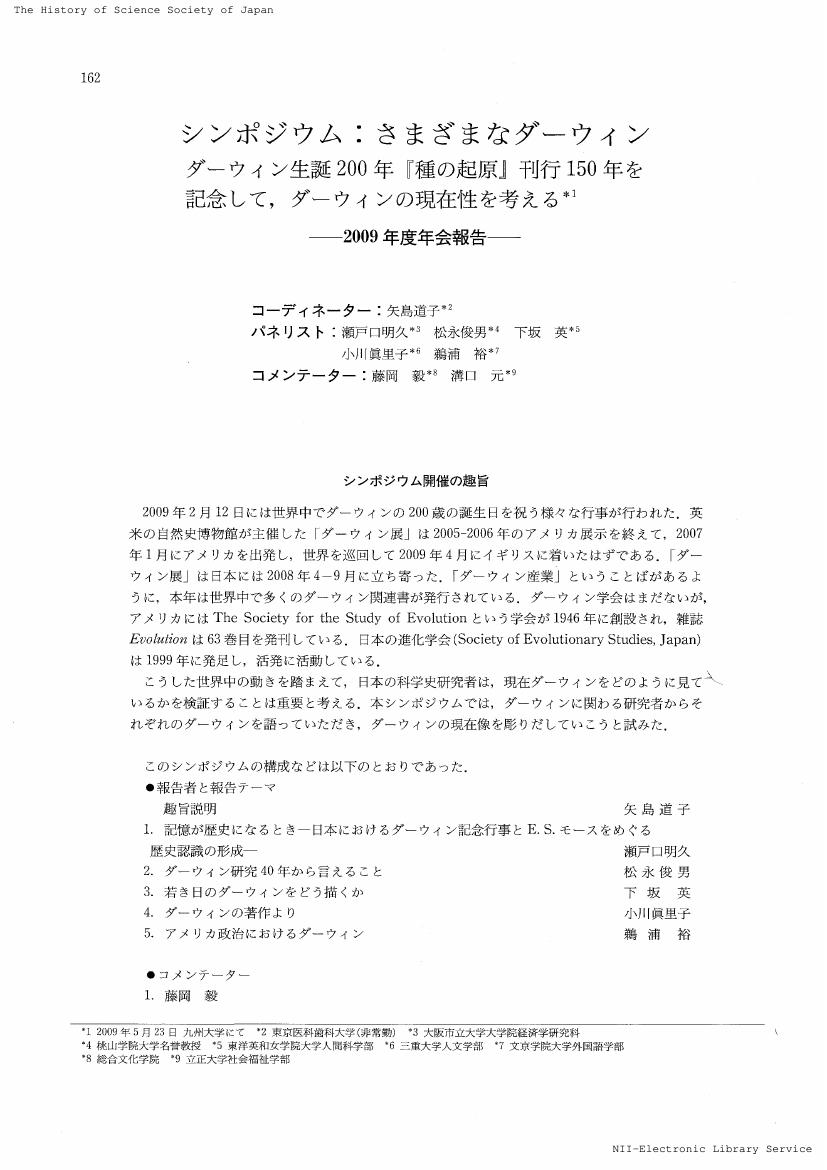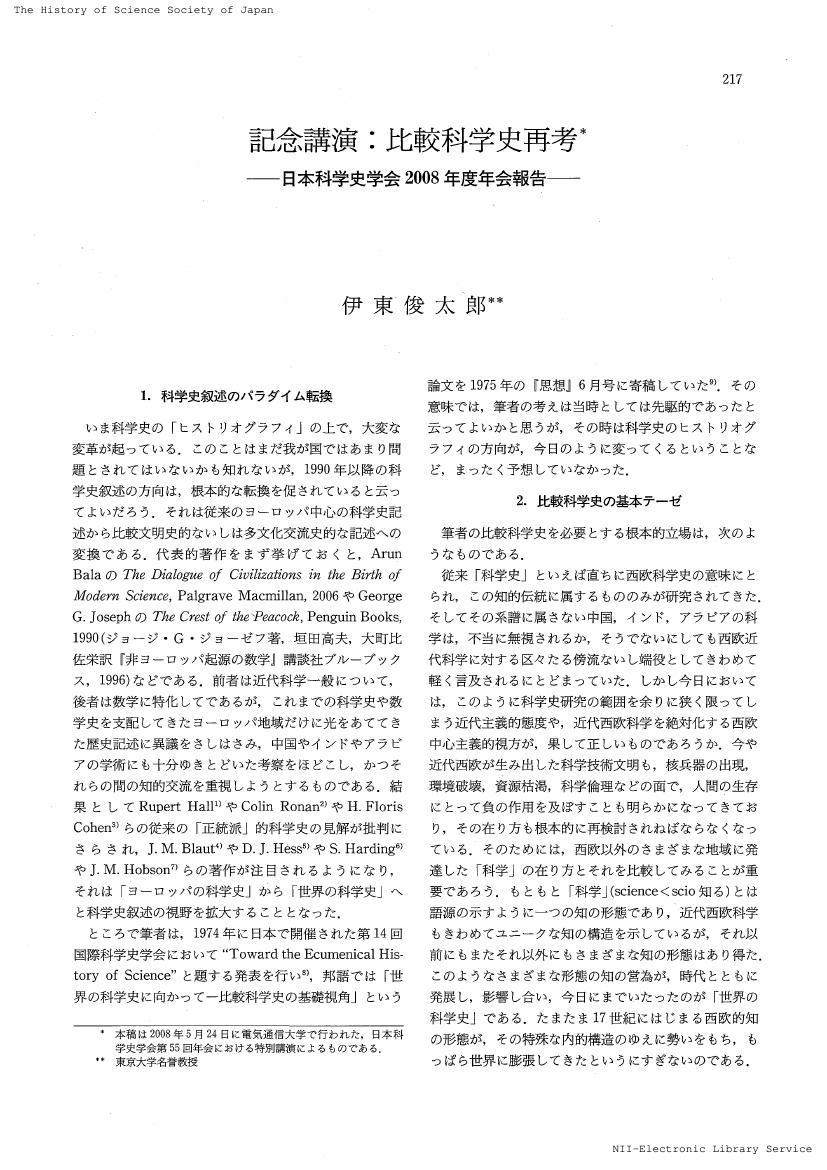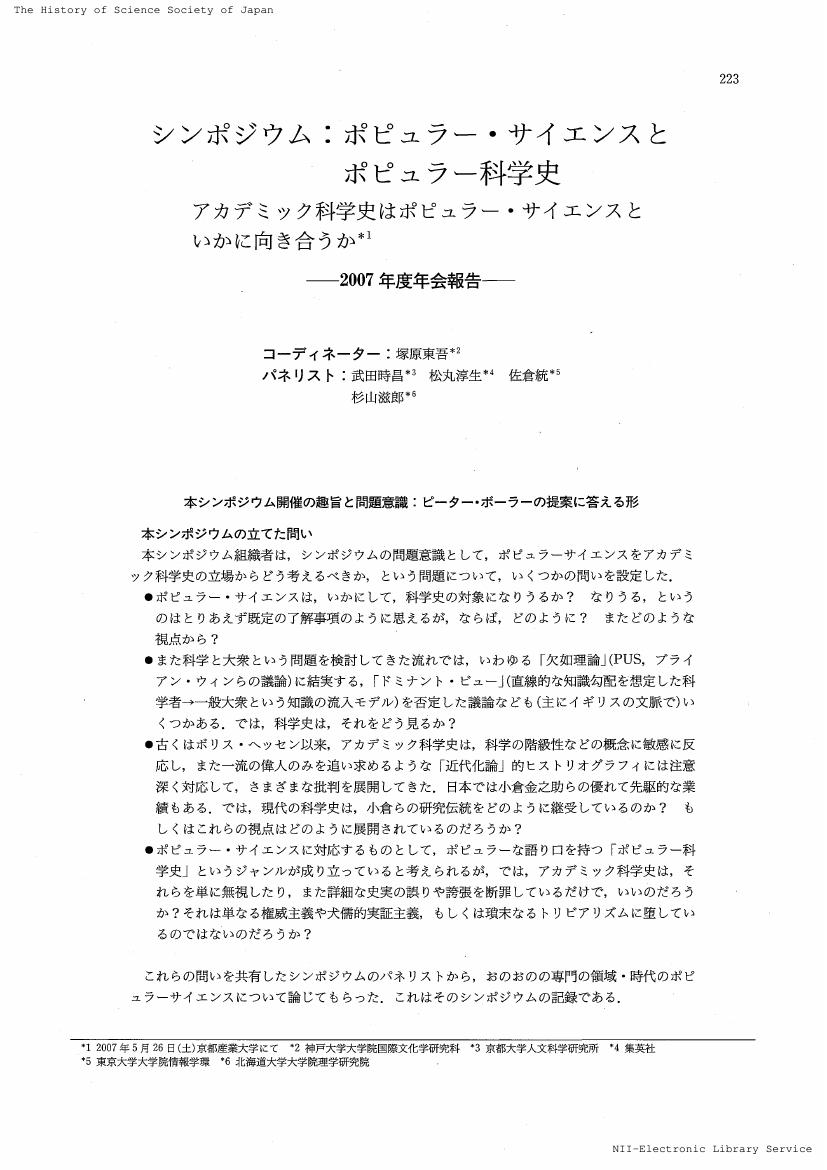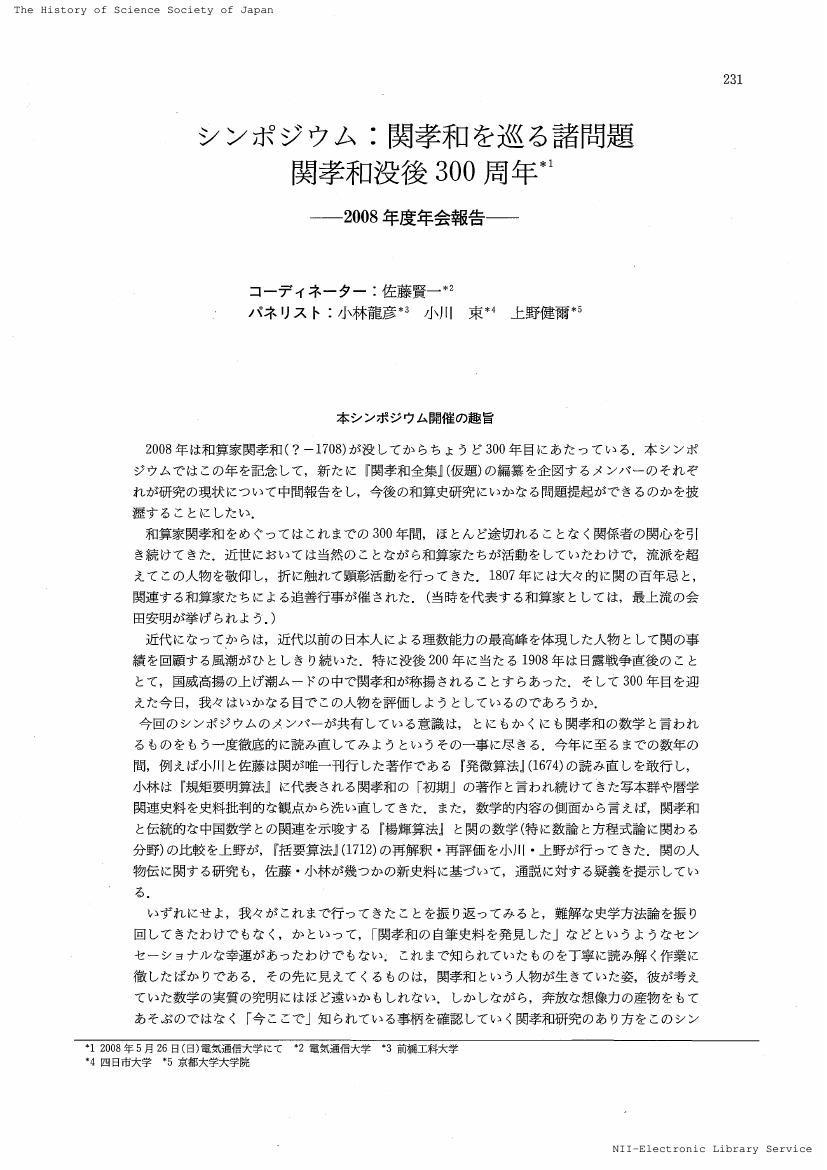1 0 0 0 OA 幕府天文方高橋至時 : その生涯,業績と影響(科学史入門)
- 著者
- 中村 士
- 出版者
- 日本科学史学会
- 雑誌
- 科学史研究 (ISSN:21887535)
- 巻号頁・発行日
- vol.48, no.251, pp.156-161, 2009 (Released:2021-08-03)
1 0 0 0 OA 第3回日本科学史学会賞の報告
- 出版者
- 日本科学史学会
- 雑誌
- 科学史研究 (ISSN:21887535)
- 巻号頁・発行日
- vol.48, no.251, pp.179-180, 2009 (Released:2021-08-03)
1 0 0 0 OA ギリシアの医学思想における「パンゲネシス」の系譜
- 著者
- 今井 正浩
- 出版者
- 日本科学史学会
- 雑誌
- 科学史研究 (ISSN:21887535)
- 巻号頁・発行日
- vol.48, no.249, pp.22-33, 2009 (Released:2021-08-04)
The Pangenetic theory which holds that sperm comes from all the body seems to have been one of the most remarkable doctrines in Greek biology in the fifth and fourth centuries BC, since Aristotle gives a detailed description of the theory and criticizes it severely. The main sources of information about the Pangenetic theory are several medical treatises in the Hippocratic Corpus. There are only some mentions of it in the extant fragments ascribed to Democritus. It would be probable, therefore, that the theory had the origin of its theoretical form in the tradition of Greek medical science, and then came to the focus of attention among the Presocratic philosophers. Some scholars, on the other hand, claim that Democritus had a decisive role in the formation and development of the theory, which was then taken over by the Hippocratic doctors in their attempt to give a systematic explanation for some of the important genetic issues, such as the inheritance of similarities from parents to their children. It must be kept in mind, however, that Hippocratic doctors thought of particular fluids or humours with their inherent powers (δυναμειs) as the essential constituents of human body. This fact leads us to have an idea that the doctors had a completely different view of matter from the corpuscular theory, although Lesky (1950) and Lonie (1981) assume them to have been almost dependent on the atomism of Democritus. We can conclude that the Pangenetic theory came originally from Greek medical science, and then developed into the most influential doctrine before Aristotle.
1 0 0 0 OA 紹介
- 出版者
- 日本科学史学会
- 雑誌
- 科学史研究 (ISSN:21887535)
- 巻号頁・発行日
- vol.48, no.249, pp.54-60, 2009 (Released:2021-08-04)
- 著者
- 有賀 暢迪
- 出版者
- 日本科学史学会
- 雑誌
- 科学史研究 (ISSN:21887535)
- 巻号頁・発行日
- vol.48, no.250, pp.77-86, 2009 (Released:2021-08-04)
The principle of least action owes its modern formulation to Lagrange (1736-1813), who also related its "pre-modern" history in his Mechanique analitique (1788): Maupertuis (1698-1759) treated it in an ambiguous manner, while Euler (1707-1783) formulated it more precisely. Recent historical studies have shown, however, the difficulty of maintaining this narrative, for these two scholars departed from different problems and reached at different formulations of the principle. In general agreement with these views, this paper emphasizes a further, crucial distinction between Maupertuis and Euler-their usage of the term "quantity of action." When Maupertuis spoke of "quantity of action," he referred to a product of mass, velocity and distance, and his main concern was with the instanteneous change of two bodies colliding. Euler, on the other hand, investigated various "mechanical curves" under the continuous action of forces, searching for a quantity which was minimum to these curves. He realized then that these minimum quantites could be derived from a single one, which he named "effort." Euler did not accept Maupertuis's definition of the "quantity of action" but identified it with the "effort." Although Euler had acquired the idea of "effort" from Maupertuis's earlier work on the "law of rest," Maupertuis himself did not appraise it so highly. They disagreed over what "quantity of action" meant, and their disagreement was related to the kind of physical problems with which they were concerned; before Lagrange's modern formulation, there were two quite distinct principles of least action.
1 0 0 0 OA 本渓湖煤鉄公司の形成に関する歴史的研究
- 著者
- 木場 篤彦
- 出版者
- 日本科学史学会
- 雑誌
- 科学史研究 (ISSN:21887535)
- 巻号頁・発行日
- vol.48, no.250, pp.87-97, 2009 (Released:2021-08-04)
This thesis studies the Benxi Steel Complex which was constructed at Penshifu (Benxi), Manchuria by a Japanese zaibatsu group named Okura. It focuses on this Complex's development from its beginning in 1906 to 1945, when it was taken over by China following the Japanese defeat in World War 2. There are a few existing studies on the Complex. But these studies do not offer a good analysis of its overall industrial history. This thesis aims to analyze the Complex's whole history and its development with a reference to its manufacturing structure. The Complex was originally a coal mining company. After Okura Group acquired the mining rights of the Miaoergou's iron ore mine, the Complex became a pig iron maker. Penshifu was an ideal place for steel making, because there were in its vicinity all kind of mines including iron ore, coal and limestone. However, because iron ore is magnetite poor ore, the Complex had to acquire specific manufacturing technologies such as magnetic concentration and low phosphorus pig iron manufacturing. The Complex produced low phosphorus pig iron which the Japanese Navy needed. After the Manchurian Incident, the munitions boom occurred, benefitting the company. The Complex then started to expand its manufacturing facilities. After 1937, the Complex executed "The Manchukuo Industry Five Year Program", and constructed a special steel manufacturing division. However, the complex ran into financial difficulties, and failed in the full-scale production of special steel.
1 0 0 0 OA 日本最古の徳川義直公望遠鏡
- 著者
- 中村 士
- 出版者
- 日本科学史学会
- 雑誌
- 科学史研究 (ISSN:21887535)
- 巻号頁・発行日
- vol.48, no.250, pp.98-108, 2009 (Released:2021-08-04)
Although historical records show that a telescope was first brought about into Japan as early as in 1613, existing telescopes in Japan produced before 1750 are rare and have never been examined in detail. In 2003 and 2005, we had a chance to scrutinize the antique telescope owned by one of feudal warlords, Tokugawa Yoshinao, who was the ninth son of the first Shogun Iyeyasu and inherited a large han (clan) at Owari-Nagoya district. Since Yoshinao died in 1650, it means that his telescope was made in or before that year. Our investigations of the telescope revealed that it is of Schyrlean type, namely, a more advanced one than the Galilean telescope, consisting of four convex lenses. In Europe, the invention of the Schyrlean telescope was publicized in 1645. Optical measurements showed that Yoshinao's telescope gave erect images with a measured magnifying power of 3.9 (+/- 0.2-0.3). The design, fabrication technique of the tube and caps of the telescope, and tube decoration all point to that it is neither a Western product at all nor a pure Japanese make. It is likely that the telescope was produced probably under the guidance of the Jesuit missionary in China or by the native Chinese, near cities of Suzhou or Hangzhou in Zhejiang province of the continental China, or at Nagasaki. Based on the Japanese and Chinese historical literature, we also discuss the possibility that production of the Schyrlean telescope could have begun independently in the Far East, nearly simultaneously with the invention of that type in Europe.
1 0 0 0 OA ロックフェラー財団とNiels Bohrのサイクロトロン開発
- 著者
- 日野川 静枝
- 出版者
- 日本科学史学会
- 雑誌
- 科学史研究 (ISSN:21887535)
- 巻号頁・発行日
- vol.48, no.250, pp.109-119, 2009 (Released:2021-08-04)
The cyclotron was invented and developed in the 1930s as an experimental device for nuclear physics. The Rockefeller Foundation was deeply involved in the construction and operation of cyclotrons, not only in the United States, where this machine was invented, but also in many other countries. The Foundation's grants, however, were designated not for nuclear physics research but for so-called Experimental Biology, a research program launched by Warren Weaver, then the Rockefeller Foundation's Director for the Natural Sciences. One exception to this policy was the funding granted to Niels Bohr in Copenhagen. In order to justify their new experimental biology program, Weaver and his associates strongly desired the participation of Bohr, a renowned physicist. To accomplish this purpose, they drew Georg Charles von Hevesy, who desired to escape Nazi Germany, to Bohr's laboratory to participate in the experimental biology project in Copenhagen. Their cyclotron was used to produce radioactive isotopes, which were essential to Hevesy's research using isotope tracer techniques. Hence the Foundation made this exception, twice awarding grants to Bohr, who wanted to do nuclear research, for the construction and operation of a cyclotron.
- 著者
- 伊東 俊太郎
- 出版者
- 日本科学史学会
- 雑誌
- 科学史研究 (ISSN:21887535)
- 巻号頁・発行日
- vol.47, no.248, pp.217-222, 2008 (Released:2021-08-04)
1 0 0 0 OA シンポジウム:関孝和を巡る諸問題 関孝和没後300周年-2008年度年会報告-
1 0 0 0 OA 球惑星科学連合の地球科学史・地球科学論セッションを開催して(アゴラ)
- 著者
- 矢島 道子 山田 俊弘
- 出版者
- 日本科学史学会
- 雑誌
- 科学史研究 (ISSN:21887535)
- 巻号頁・発行日
- vol.47, no.248, pp.246-247, 2008 (Released:2021-08-04)
1 0 0 0 OA 紹介
- 出版者
- 日本科学史学会
- 雑誌
- 科学史研究 (ISSN:21887535)
- 巻号頁・発行日
- vol.47, no.248, pp.248, 2008 (Released:2021-08-04)
1 0 0 0 OA 日本における「平和のための原子(アトムズ・フォー・ピース)」政策の展開
- 著者
- 山崎 正勝
- 出版者
- 日本科学史学会
- 雑誌
- 科学史研究 (ISSN:21887535)
- 巻号頁・発行日
- vol.48, no.249, pp.11-21, 2009 (Released:2021-08-04)
In the early years of the Cold War, both the United States and the Soviet Union used their nuclear power technology as a diplomatic tool for expanding their political influence on respective friendly nations. On December 8, 1953, the United States initiated a new international nuclear program with President Dwight D. Eisenhower's "Atoms for Peace Address" before the General Assembly of the United Nations. This program regarded Japan as one of the most promising countries that could introduce nuclear power plants since it consumed a huge amount of energy while being short of natural resources. This paper studies the historical process of the atomic energy agreement between Japan and the US in 1955 using declassified documents in both countries. It shows that in spite of various proposals of the introduction of nuclear power plants into Japan including that of Congressman Sydney Yates, the final agreement was only for research reactors because American authorities felt that such proposals might mean an admission of US guilt in atomic bombing. It also argues that the agreement was one of steps toward the hegemony of bureaucrats and politicians in Japanese nuclear policy that made the leadership of scientists, especially those of the Science Council of Japan, decline.
1 0 0 0 OA 蔡倫以前紙に関する学術論争
- 著者
- 小林 良生
- 出版者
- 日本科学史学会
- 雑誌
- 科学史研究 (ISSN:21887535)
- 巻号頁・発行日
- vol.47, no.247, pp.150-159, 2008 (Released:2021-08-04)
During the past half a century archaeologists in China excavated some paper-like remnants dating from the Western Han Dynasty. Based on these findings, Pan Jinxing proposed that paper was invented before Ts'ai Lun, doubting on his contribution to the invention of papermaking technology. With the publication of new Academic Journal named "Paper History Study", China Technical Association of the Paper Industry Society members strongly opposed his opinions by re-analyses all of the unearthed papers and historical references. The major counter-evidences are as follows: a. there existed mis-judgments on produced ages of unearthed papers or paper-like objects, b. Some of the unearthed papers reported were not paper but paper-like objects made of botanical fibers bundles due to natural force or primitive paper-like models and the stormy discussion was made on the definition of paper, c. there are referential supports on the Ts'ai Lun's originality on the invention of papermaking. These conclusive remarks expressed by the Association of Paper Industry were compared with those of Pan Jinxing in the form of the table. The final conclusion on the existence of "the papers before Ts'ai Lun", therefore, must await further scientific analyses by the disinterested party.
1 0 0 0 OA シンポジウム:日本のコンピュータ史 研究開発における諸機関の連携-2008年度年会報告-
1 0 0 0 OA 第2回日本科学史学会賞の報告
- 出版者
- 日本科学史学会
- 雑誌
- 科学史研究 (ISSN:21887535)
- 巻号頁・発行日
- vol.47, no.247, pp.176-179, 2008 (Released:2021-08-04)
1 0 0 0 OA 第55回日本科学史学会年会・総会報告
- 出版者
- 日本科学史学会
- 雑誌
- 科学史研究 (ISSN:21887535)
- 巻号頁・発行日
- vol.47, no.247, pp.180-185, 2008 (Released:2021-08-04)












